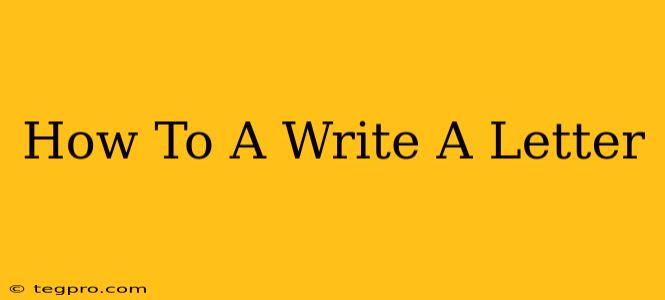Writing a letter might seem old-fashioned in our digital age, but the art of crafting a well-written letter remains relevant and valuable. Whether it's a formal business letter, a heartfelt personal note, or a friendly email, knowing how to write effectively can significantly impact your communication. This guide will walk you through the process, covering various letter types and offering practical tips to help you write compelling and effective correspondence.
Understanding the Purpose of Your Letter
Before you even begin writing, it's crucial to define the purpose of your letter. What do you want to achieve? Are you requesting information, expressing gratitude, making a complaint, or conveying condolences? Understanding your objective will guide your tone, structure, and content.
Types of Letters:
- Formal Letters: These are used for professional communication, such as job applications, business inquiries, or official complaints. They require a formal tone, specific formatting, and a clear, concise structure.
- Informal Letters: These are used for personal communication with friends, family, and acquaintances. They allow for a more relaxed tone and greater flexibility in structure and content.
- Business Letters: These letters are highly structured and formal, often following a specific business letter format. They generally include a heading, date, recipient address, salutation, body, closing, and signature.
- Cover Letters: These accompany resumes and highlight your skills and experience relevant to the job you're applying for. They should be tailored to each specific job application.
- Thank You Letters: These express gratitude for a gift, service, or opportunity. They are important for maintaining positive relationships.
- Complaint Letters: These express dissatisfaction with a product or service. They should be written calmly and professionally, clearly stating the issue and desired resolution.
Crafting Your Letter: Step-by-Step Guide
Regardless of the letter type, follow these steps for a well-structured and effective letter:
1. Planning and Outlining:
- Identify your audience: Who are you writing to? Your tone and language will vary depending on your audience.
- Determine your key message: What is the most important point you want to convey?
- Outline your main points: Organize your thoughts into a logical sequence. This will help ensure your letter is clear and easy to follow.
2. Writing the First Draft:
- Start with a strong opening: Grab your reader's attention and clearly state your purpose.
- Develop your main points: Provide clear, concise, and supportive details for each point.
- Maintain a consistent tone: Your tone should be appropriate for your audience and purpose.
- Use clear and concise language: Avoid jargon or overly complex sentences.
- Proofread carefully: Check for any grammatical errors or typos before moving on.
3. Revising and Editing:
- Read your letter aloud: This helps identify awkward phrasing or unclear sentences.
- Get feedback from others: Ask a friend or colleague to review your letter for clarity and effectiveness.
- Refine your language: Replace weak words with stronger ones, and ensure your writing is engaging.
- Ensure your letter is well-formatted: Pay attention to spacing, font size, and overall presentation.
4. Finalizing and Sending:
- Proofread one last time: Ensure there are no remaining errors.
- Choose the appropriate method of sending: Mail, email, or hand-delivery are all options. Choose the method most appropriate for your purpose and audience.
Tips for Effective Letter Writing
- Use strong verbs: Active voice makes your writing more direct and engaging.
- Keep paragraphs short: Brevity makes your letter easier to read and understand.
- Use proper punctuation and grammar: This ensures your letter is professional and credible.
- Tailor your letter to your audience: Consider their knowledge, perspective, and expectations.
- Be respectful and courteous: Even when expressing a complaint, maintain a respectful tone.
Mastering the art of letter writing is a valuable skill that can enhance your communication in both personal and professional settings. By following these steps and tips, you can craft effective and compelling letters that achieve your desired outcome. Remember, practice makes perfect! The more you write, the better you'll become at conveying your message clearly and effectively.

